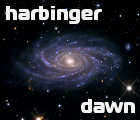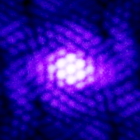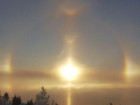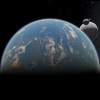|
The Galaxy at the Center of the Universe.
|
|
| Sting | Date: Saturday, 28.06.2014, 23:27 | Message # 1 |
 Observer
Group: Newbies
 United States
United States
Messages: 5
Status: Offline
| I know its prob not plausible by modern science. But I think I found the original big bang galaxy 
Its 6,070 TRILLION stars, and its Coordinates are RG 0-0-0-0 Largest Galaxy I have found in SE.
Beautiful looking galaxy too.
|
| |
| |
| SolarLiner | Date: Saturday, 28.06.2014, 23:42 | Message # 2 |
 Explorer
Group: Users
 France
France
Messages: 267
Status: Offline
| The Cosmological Principle is directly against a single "center" in the universe, you may want to see it differently: everything is at the center of the universe. You, me, SpaceEngineer, etc. are all at the center of the universe, because it is expanding. You think you are the center, because everything around you is getting away. Walk a few hundred parsecs, and you'll still think that because everything is still getting away from you.
Now I agree that is a good looking galaxy 
custom landing page to share: http://bit.ly/spaceengine
|
| |
| |
| Sting | Date: Sunday, 29.06.2014, 01:50 | Message # 3 |
 Observer
Group: Newbies
 United States
United States
Messages: 5
Status: Offline
| I know, but Im talking about the originally point where the big bang happened. I read a fan fiction conclusion to Stargate Universe where the Destiny (The ship) reaches the spot where the actual big bang happened. and its a galaxy with an unusual black hole at the center which promoted my idea to search for this.
|
| |
| |
| HarbingerDawn | Date: Sunday, 29.06.2014, 02:23 | Message # 4 |
 Cosmic Curator
Group: Administrators
 United States
United States
Messages: 8717
Status: Offline
| Sting, first, the big bang happened everywhere. It did not happen at a specific place, it is simply what we call the entire universe in its earliest moments. Second, please read the forum rules. There is already a thread about RG 0-0-0-0, and so there was no reason to make another.
All forum users, please read this!
My SE mods and addons
Phenom II X6 1090T 3.2 GHz, 16 GB DDR3 RAM, GTX 970 3584 MB VRAM
|
| |
| |
| FastFourierTransform | Date: Sunday, 29.06.2014, 03:35 | Message # 5 |
 Pioneer
Group: Local Moderators
 Spain
Spain
Messages: 542
Status: Offline
| The Big Bang happened at a very particular point indeed. But the misconception, as HarbingerDawn has explained, is considering this a point in 3D space. The universe began at a tetradimensional point with well known coordinates. For the x, y and z axis youa can asign every value you want and for the 4th coordinate (time) the value is zero. Those are the coordinates. The universe is not expanding, as we see in educational videos, ass a bubble (with a center of expansion) it is expanding as a four dimensional bubble. And there's not a central galaxy or central 3D point from wich all the velocity vectors of all the other galaxies and points of space expand radially. But there is an expansion in a 4th dimensional space-time radial to a 4th dimensional center that we call "everywhere 13.8 billion years ago".
|
| |
| |
| Watsisname | Date: Sunday, 29.06.2014, 06:52 | Message # 6 |
 Galaxy Architect
Group: Global Moderators
 United States
United States
Messages: 2613
Status: Offline
| While technically correct, thats seriously over-explaining it -- I think most people would read that and end up more confused than they were to begin with. The Big Bang and nature of the expansion is not that complicated.
The biggest misconception about the Big Bang is that it was an explosion of stuff coming from an infinitely dense point. This is wrong, and is what leads people to ask such questions as "where was that point?", "where is the center?", and "what's beyond the edge / what is the universe expanding into?" All of these questions are meaningless.
The correct description of the Big Bang is that the density was (at least essentially) infinite everywhere, and it is the space itself which is expanding, not the stuff within it that is expanding as in a standard explosion.
To try to visualize it, just imagine the grid of a chess/checker board, with the edges extended out indefinitely. Now imagine size of the grid squares growing larger with time. Or, reversing time, they everywhere are compacted, eventually to zero size, which is the moment of the Big Bang. This looks not like a point in space, but an infinitely large space uniformly filled with infinitely small grid squares.

|
| |
| |
| midtskogen | Date: Sunday, 29.06.2014, 13:15 | Message # 7 |
 Star Engineer
Group: Users
 Norway
Norway
Messages: 1674
Status: Offline
| Quote Watsisname (  ) To try to visualize it, just imagine the grid of a chess/checker board, with the edges extended out indefinitely. Now imagine size of the grid squares growing larger with time. Or, reversing time, they everywhere are compacted, eventually to zero size, which is the moment of the Big Bang. This looks not like a point in space, but an infinitely large space uniformly filled with infinitely small grid squares.
While the current best guesses for the shape of the universe might favour a flat, infinite universe, I don't think the Big Bang theory itself dictates a specific shape?
NIL DIFFICILE VOLENTI

|
| |
| |
| Watsisname | Date: Sunday, 29.06.2014, 20:39 | Message # 8 |
 Galaxy Architect
Group: Global Moderators
 United States
United States
Messages: 2613
Status: Offline
| They are not guesses. The geometry follows directly from the Ricci curvature tensor in general relativistic field equations, which with observations of universe's matter/energy content, and evolution of scale factor with time, indicate the universe is extremely close to flat. Whether it is infinite (bounded or unbounded) is unknown. However, this is irrelevant to the purpose of the visualization.
The visualization is meant to show how metric expansion works, going back to the initial instant without falling for the misconception of thinking of everything being confined to a point within space. Even in a closed model, that would be wrong -- a time reversed observer sees the mass density increasing everywhere.
In other words, the Big Bang looks like an infinity in the density, not size. This is a subtle but very important concept.

|
| |
| |
| SpaceEngineer | Date: Sunday, 29.06.2014, 20:40 | Message # 9 |
 Author of Space Engine
Group: Administrators
 Russian Federation
Russian Federation
Messages: 4800
Status: Offline
| Quote SolarLiner (  ) You, me, SpaceEngineer, etc. are all at the center of the universe, because it is expanding.
But I don't move away from you  Earth don't expand together with space. Solar system, Galaxy - too. bodies, bonded by gravitational or other strong forces don't expand. Earth don't expand together with space. Solar system, Galaxy - too. bodies, bonded by gravitational or other strong forces don't expand.
Quote midtskogen (  ) While the current best guesses for the shape of the universe might favour a flat, infinite universe, I don't think the Big Bang theory itself dictates a specific shape?
It was derived from observation of distant supernovae, what gives us a value of curvature of space-time, what is very close to zero. This mean what Universe is flat (ie Euclidean, not warped).

|
| |
| |
| Sting | Date: Sunday, 29.06.2014, 21:21 | Message # 10 |
 Observer
Group: Newbies
 United States
United States
Messages: 5
Status: Offline
| Does anyone have a documentary about the big bang happening at all places at once? Every thing Ive seen on it said it started from a singularity the size of a pea. So I'm pretty confused.
(I learn things visually which is one of the reasons why I play Space Engine.)
|
| |
| |
| HarbingerDawn | Date: Monday, 30.06.2014, 00:44 | Message # 11 |
 Cosmic Curator
Group: Administrators
 United States
United States
Messages: 8717
Status: Offline
| Quote Sting (  ) Every thing Ive seen on it said it started from a singularity the size of a pea.
Even if it was (which is not certain), all of space as we understand it would have been contained within that. Meaning that any point in space that you pick would still be inside that volume. So it was still everywhere, it's just that everywhere was a lot smaller back then.
All forum users, please read this!
My SE mods and addons
Phenom II X6 1090T 3.2 GHz, 16 GB DDR3 RAM, GTX 970 3584 MB VRAM
|
| |
| |
| midtskogen | Date: Monday, 30.06.2014, 07:34 | Message # 12 |
 Star Engineer
Group: Users
 Norway
Norway
Messages: 1674
Status: Offline
| Quote SpaceEngineer (  ) It was derived from observation of distant supernovae, what gives us a value of curvature of space-time, what is very close to zero. This mean what Universe is flat (ie Euclidean, not warped).
Ok, I see that it's measured flat within 0.4%, which is cool. When I did some astronomy at university 20 years ago the hard evidence was much less. Anyway, evidence of a non-Euclidean universe wouldn't necessarily contradicted a Big Bang, but the infinite chessboard may be an instructive analogy, then. And perhaps the common analogy to explain the expansion of the universe using an inflating balloon (with dots representing galaxies) is a bit misleading, since it would suggest a non-Euclidean universe.
NIL DIFFICILE VOLENTI

|
| |
| |
| Watsisname | Date: Monday, 30.06.2014, 08:08 | Message # 13 |
 Galaxy Architect
Group: Global Moderators
 United States
United States
Messages: 2613
Status: Offline
| I think they were trying to say two different things and somehow they got combined together.
1: The first instant of expansion (The Big Bang) was a singularity. This means that the density was infinite. (Keep in mind this is an extrapolation, but not by much!)
2: Shortly after the Big Bang (a very tiny fraction of a second), the region of space which is now the observable universe would have been the size of a pea.
The way they figure this out by the way is through some equations. I won't go into any great detail, but there are equations which describe how the distance between two arbitrary points in space (astronomers call this the "scale factor") changes with time due to the universe's expansion. The expansion in turn is described by the physics of general relativity. So what they are doing is taking the distance between points today to be the size of the observable universe, and calculating what that would have been at some moment in time right after the Big Bang.
In truth, there isn't anything really special about the 'size of a pea' thing. In pop-science documentaries they love to say things like this because it sounds impressive and wows the viewers. It is not wrong, exactly, but it is not actually that important of a statistic. You can make the 'size of the universe' be arbitrarily small by choosing a time arbitrarily close to the Big Bang, though of course at some point you run into conditions where our understanding of physics breaks down. (This being beyond about 10-36 or 0.000000000000000000000000000000000001 seconds after the Big Bang.) 

|
| |
| |
| FastFourierTransform | Date: Monday, 30.06.2014, 10:20 | Message # 14 |
 Pioneer
Group: Local Moderators
 Spain
Spain
Messages: 542
Status: Offline
| Quote Sting (  ) Does anyone have a documentary about the big bang happening at all places at once? Every thing Ive seen on it said it started from a singularity the size of a pea.
What you see in documentaries isn't the truth at it's own. It's only a poor visualization of what the real language of truth (mathematics) tells us. You can watch one hundred clips where you see an explosion and some Morgan Freeman's voice talling you something about the big BANG!! but the fact is that nothing like that happend. Scientific divulgation has quite a big number of problems to solve in the more advanced physics and to solve this kind of intricacies and show to the people they always reduce what you are learning to a bunch of methaphores and not so complex analogs. The probolem is that this generates continuous missconceptions about physics, and not only!, this also generate very simplistic and not so spectacular, as one might think, perspectives.
Quote Sting (  ) I learn things visually
Well, if you want to trully know you have to learn mathematics visually because no one can show you an accurate visualization of the big bang. Can you view 4 dimensional space-time curved? if you want I can show you a projection of that over a 3D flat representation or a 2D spoacelike curved representation (ussualy used to explain metric expantion with baloons), but if you trully want to understand you have to learn maths and try to immagine all over your life, how a 4D curved dinamical space-time looks like. Or how it looks like an explosion that occurs everywhere is seen from the inside and without light passing through the dense material of that explosion until 377000 years. This is related to the false representation of black holes as a curved two dimensional mesh like a funnel when in reality we are dealing with a 4th dimensional funnel (tell me how to visualize that without making this more confusing). The missconceptions go extreme in some fields of physics as quantum mechanics, where we can say many physicists have deep trouble trying to comprehend as you are having now.
But if you want some documentary-like scenes where they say things like this about the universe (no center, expanding where?, explosion?, faster than light? infinite but bounded¿?) I can show you these little clips:
https://www.youtube.com/watch?v=5NU2t5zlxQQ
https://www.youtube.com/watch?v=q3MWRvLndzs
https://www.youtube.com/watch?v=W4c-gX9MT1Q
https://www.youtube.com/watch?v=XBr4GkRnY04
|
| |
| |